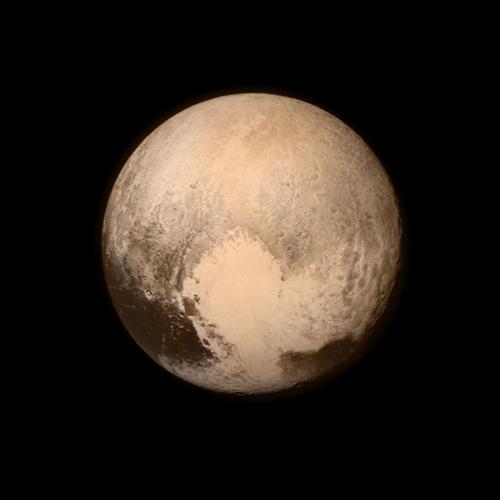The New Horizons mission to Pluto isn’t rewriting the textbooks, says NASA spokesman Dwayne Brown.
“It is writing the textbooks,” he said, as he closed a Friday press briefing with mission scientists.
Pluto has been something of a blank slate — a tiny point of light in the sky — since its discovery in 1930.
New Horizons, traveling for more than nine years and 3 billion miles, gave it its first close-up on July 14.
As of Friday, the spacecraft had downloaded about 4 to 5 percent of the data it collected on two cameras and five scientific instruments, but even that little bit of information is changing our view of Pluto.
Here are seven things we did not know about Pluto before we went there.
Pluto has five moons
We knew Pluto had at least five moons. The surprise is that there aren’t more of them.
Mark Showalter, who discovered two of Pluto’s moons as the mission was making its nine-year journey, said he truly expected to find many more, as did Alan Stern, the mission’s principal investigator.
Five may not be the final count, but if any more exist they were too small and too dim to see during New Horizons’ approach.
The moons are named for underworld figures in mythology.
The largest, often called a co-planet because of its size and closeness, is Charon. The others are Styx, Nix, Kerberos and Hydra.
Pluto has mountains
The New Horizons team has informally named Pluto’s icy mountain ranges for the first two men known to reach the peak of Mount Everest, though the two ranges found so far are not Himalayan in stature — more the height of the Rockies and the Appalachians.
The taller range is named Norgay Montes, in honor of Nepalese mountaineer Tenzing Norgay, and the smaller range is named for Sir Edmund Hillary.
The composition information is not yet transmitted, but Stern said the height of those mountains could not be supported by the frozen gases omnipresent on Pluto’s surface. He predicted they will be identified as water ice.
Pluto has a heart
That heart-shaped feature in the iconic image put together by the NASA team as New Horizons approached the ninth planet is real.
It’s outlines may blur — or be enhanced — as more data is received, but it is there and it is a real region of icy plains outlined by darker features, including those two mountain ranges.
The team informally named it Tombaugh Regio in honor of Pluto discoverer Clyde Tombaugh.
Pluto has a tail
No, we’re not talking about Pluto the dog, whose name was changed by the Disney folks from Rover to Pluto shortly after Clyde Tombaugh discovered the planet in 1930.
The planet Pluto’s tail consists of ionized particles of nitrogen being blown off its surface by solar winds. They were detected by New Horizons Solar Wind Around Pluto (SWAP) instrument as the spacecraft sped away from the planet.
Pluto is smoother than expected
Scientists expected Pluto’s surface to be pocked with craters.
Its orbit traverses the Kuiper Belt, which is filled with up to a trillion icy objects. Repeat collisions are inevitable over billions of years.
The New Horizons images, however, show miles of icy plains, untouched by collisions.
What does this mean? Well, it means something is reshaping Pluto’s surface and erasing evidence of past collisions. It could be internal (tectonic) forces or atmospheric ones.
William McKinnon, a New Horizons co-investigator from Washington University in St. Louis, said Friday that nitrogen ice is flowing from the plains into craters at the rocky edge.
“We knew nitrogen ice was there. To see evidence for recent geological activity is a dream come true.”
By recent, McKinnon said he meant “no more than a few tens of millions of years. There is no reason it can’t be going on today.”
Pluto is big (enough)
For most of its life Pluto has been the incredible shrinking planet. When first discovered, astronomers thought it was the size of Jupiter, then Earth, then Earth’s moon.
We’ve known for a while that it is about two-thirds the size of our moon, but New Horizons took a more exact measurement.
It is 1,473 miles in diameter.
That makes it bigger than Eris, the largest of its known rivals in the Kuiper Belt. And that makes it, as the NASA press releases say: “The King of the Kuiper Belt.”
Pluto is red
The real color images of Pluto captured by New Horizons show it to have a variety of light and dark features — with an overall rusty red tint.
At a NASA press conference Friday, Michael Summers, a New Horizons co-investigator from George Mason University, offered a possible explanation.
He said sunlight is breaking up sublimated methane into complex hydrocarbons, such as ethylene and acetylene.
They in turn are converted into tholins — reddish hydrocarbons that fall to the surface and give the planet its hue.









